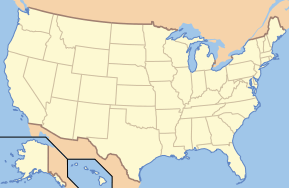Lewis and Clark National and State Historical Parks
| Lewis and Clark National and State Historical Parks | |
|---|---|
|
IUCN category V (protected landscape/seascape) | |
|
Fort Clatsop replica built in 2007 | |
 | |
| Location | Clatsop County, Oregon and Pacific County, Washington, USA |
| Nearest city | Astoria, Oregon |
| Coordinates | 46°8′1″N 123°52′39″W / 46.13361°N 123.87750°WCoordinates: 46°8′1″N 123°52′39″W / 46.13361°N 123.87750°W |
| Area | 3,303 acres (13.37 km2)[1] |
| Established | May 29, 1958 |
| Visitors | 191,867 (in 2011)[2] |
| Governing body | National Park Service |
| Website | Lewis and Clark National Historical Park |
|
Fort Clatsop and the Salt Works | |
| Area | 125 acres (51 ha) |
| Built | 1805 |
| Architect | Capt. William Clark |
| NRHP Reference # | 66000640 |
| Added to NRHP | October 15, 1966[3] |
The Lewis and Clark National and State Historical Parks, in the vicinity of the mouth of the Columbia River, commemorate the Lewis and Clark Expedition. Administration of the parks is a cooperative effort of the United States National Park Service and the states of Oregon and Washington, and was dedicated on November 12, 2004.
After reaching the Pacific Ocean, the Corps of Discovery camped at Fort Clatsop in the winter of 1805–1806. The parks also preserve several landing sites on the north bank of the river in Washington, and other sites in Oregon.
Lewis and Clark National Historical Park
The federal park began as Fort Clatsop National Memorial which was established on May 29, 1958. The memorial was listed on the National Register of Historic Places on October 15, 1966. On October 30, 2004, it was redesignated Lewis and Clark National Historical Park with expanded jurisdiction over multiple sites,[4] including:
- Clark's Dismal Nitch[4]
- Fort Clatsop
- Fort to Sea Trail (dedicated on November 14, 2005)
- Memorial to Thomas Jefferson
- Netul Landing
- Salt Works
- Station Camp
Oregon state parks
Ecola State Park
Ecola was the site of the Corps of Discovery's 1806 trek over difficult terrain to see a beached whale. Today, it features several miles of hiking trails through old growth forest, and several beaches. Haystack Rock and the Needles are visible from many sites in the park. Much of the 1985 film The Goonies was filmed there, the school picnic scene in Kindergarten Cop, and the final scenes of the 1991 film Point Break were filmed at Indian Beach in the park. Scenes from the 2008 movie Twilight were filmed at Indian Beach as well.
Fort Stevens State Park
Fort Stevens, with its 3,700-acre (1,500 ha) park, offers exploration of history, nature, and recreational opportunities. The fort was the primary military defense installation in the three fort Harbor Defense System at the mouth of the Columbia River (Fort Canby and Fort Columbia were other two).
Sunset Beach State Recreation Area
Sunset Beach is the terminus of the Fort To Sea Trail, which begins in Fort Clatsop. Sunset Beach also provides visitors with direct access to the Pacific Ocean with expansive views from Cape Disappointment to the north and Ecola State Park to the South.
Washington state parks

Cape Disappointment State Park
Cape Disappointment, formerly known as Fort Canby State Park, is a 1,882-acre (762 ha) camping park on the Long Beach Peninsula, fronted by the Pacific Ocean. The park offers 27 miles (43 km) of ocean beach, two lighthouses, an interpretive center and hiking trails. The Cape Disappointment Historic District was listed on the National Register on August 15, 1975.
Fort Columbia State Park
Fort Columbia is an old coastal artillery post along the north side of the Columbia river outlet. At 593 acres (240 ha), the park includes an interpretive center focused on the fort and regional history.
Chinook Point, the site from which an American captain, Robert Gray, first saw the Columbia River, is part of the park. His explorations gave the United States a strong position in its later territorial contests with Great Britain.[5] Chinook Point was named a National Historic Landmark in 1961.
See also
Notes
- ↑ "Listing of acreage as of December 31, 2010". Land Resource Division, National Park Service. Retrieved 2011-06-21.
- ↑ "National Park Service Visitor Use Statistics". National Park Service.
- ↑ National Park Service (2009-03-13). "National Register Information System". National Register of Historic Places. National Park Service.
- 1 2 "Rep. Baird, Conservation Fund Announce Sale of Dismal Nitch for Lewis & Clark National Historic Park" (Press release). Rep. Brian Baird. December 5, 2005. Archived from the original (PDF) on 2008-12-12. Retrieved 2011-07-01.
- ↑ "About Captain Robert Gray". Garibaldi Museum. Archived from the original on 2011-06-23. Retrieved 2011-07-01.
References
- "Lewis and Clark National Historical Park". The National Parks: Index 2009–2011. National Park Service. Retrieved 2011-07-01.
- "Lewis and Clark National Historical Park Designation Act, 2004" (PDF). Library of Congress. Retrieved 2011-07-01.
External links
| Wikimedia Commons has media related to Lewis and Clark National and State Historical Parks. |
- "Lewis and Clark National Historical Park". National Park Service. Retrieved 2011-07-01.
- "Ecola State Park". Oregon Parks and Recreation Department. Retrieved 2011-07-01.
- "Fort Stevens State Park". Oregon Parks and Recreation Department. Retrieved 2011-07-01.
- "Cape Disappointment State Park". Washington State Parks and Recreation Commission. Retrieved 2011-07-01.
- "Fort Columbia State Park". Washington State Parks and Recreation Commission. Retrieved 2011-07-01.
- "Ecola State Park: Hiking And Park Information.". M. D. Vaden. Retrieved 2011-07-01.
- "The Lewis & Clark Expedition: Documenting the Uncharted Northwest". Teaching with Historic Places Lesson Plans. National Park Service. Retrieved 2011-07-01.
- "Writings of Lewis and Clark", broadcast from Fort Clatsop National Memorial from C-SPAN's American Writers



